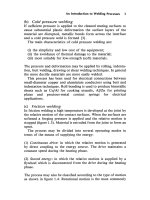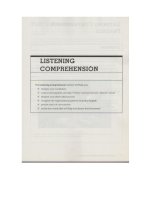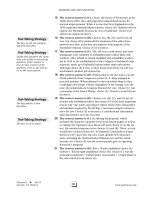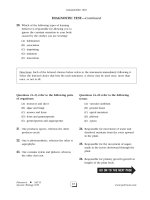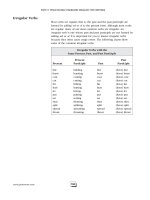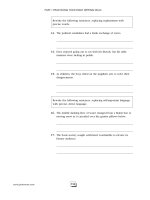New SAT Math Workbook Episode 1 part 2 potx
Bạn đang xem bản rút gọn của tài liệu. Xem và tải ngay bản đầy đủ của tài liệu tại đây (94.3 KB, 20 trang )
Operations with Whole Numbers and Decimals
5
www.petersons.com
1. Divide 391 by 23.
(A) 170
(B) 16
(C) 17
(D) 18
(E) 180
2. Divide 49,523,436 by 9.
(A) 5,502,605
(B) 5,502,514
(C) 5,502,604
(D) 5,502,614
(E) 5,502,603
4. DIVISION OF WHOLE NUMBERS
The number being divided is called the dividend. The number we are dividing by is called the divisor. The answer
to the division is called the quotient. When we divide 18 by 6, 18 is the dividend, 6 is the divisor, and 3 is the
quotient. If the quotient is not an integer, we have a remainder. The remainder when 20 is divided by 6 is 2,
because 6 will divide 18 evenly, leaving a remainder of 2. The quotient in this case is 6
2
6
. Remember that in
writing the fractional part of a quotient involving a remainder, the remainder becomes the numerator and the
divisor the denominator.
When dividing by a single-digit divisor, no long division procedures are needed. Simply carry the remainder
of each step over to the next digit and continue.
Example:
)
658
9724
4
34 4
12
Exercise 4
3. Find the remainder when 4832 is divided by 15.
(A) 1
(B) 2
(C) 3
(D) 4
(E) 5
4. Divide 42,098 by 7.
(A) 6014
(B) 6015
(C) 6019
(D) 6011
(E) 6010
5. Which of the following is the quotient of
333,180 and 617?
(A) 541
(B) 542
(C) 549
(D) 540
(E) 545
Chapter 1
6
www.petersons.com
5. ADDITION OR SUBTRACTION OF DECIMALS
The most important thing to watch for in adding or subtracting decimals is to keep all decimal points underneath
one another. The proper placement of the decimal point in the answer will be in line with all the decimal points
above.
Example:
Find the sum of 8.4, .37, and 2.641
Solution:
8.4
.37
+ 2.641
11.411
Example:
From 48.3 subtract 27.56
Solution:
48 30
7121
.
– 2 7 . 5 6
20.74
In subtraction, the upper decimal must have as many decimal places as the lower, so we must fill in zeros where
needed.
Exercise 5
1. From the sum of .65, 4.2, 17.63, and 8, subtract
12.7.
(A) 9.78
(B) 17.68
(C) 17.78
(D) 17.79
(E) 18.78
2. Find the sum of .837, .12, 52.3, and .354.
(A) 53.503
(B) 53.611
(C) 53.601
(D) 54.601
(E) 54.611
3. From 561.8 subtract 34.75.
(A) 537.05
(B) 537.15
(C) 527.15
(D) 527.04
(E) 527.05
4. From 53.72 subtract the sum of 4.81 and 17.5.
(A) 31.86
(B) 31.41
(C) 41.03
(D) 66.41
(E) 41.86
5. Find the difference between 100 and 52.18.
(A) 37.82
(B) 47.18
(C) 47.92
(D) 47.82
(E) 37.92
Operations with Whole Numbers and Decimals
7
www.petersons.com
6. MULTIPLICATION OF DECIMALS
In multiplying decimals, we proceed as we do with integers, using the decimal points only as an indication of
where to place a decimal point in the product. The number of decimal places in the product is equal to the sum of
the number of decimal places in the numbers being multiplied.
Example:
Multiply .375 by .42
Solution:
.375
× .42
750
+ 15000
.15750
Since the first number being multiplied contains three decimal places and the second number contains two deci-
mal places, the product will contain five decimal places.
To multiply a decimal by 10, 100, 1000, etc., we need only to move the decimal point to the right the proper
number of places. In multiplying by 10, move one place to the right (10 has one zero), by 100 move two places to
the right (100 has two zeros), by 1000 move three places to the right (1000 has three zeros), and so forth.
Example:
The product of .837 and 100 is 83.7
Exercise 6
Find the following products.
1. 437 × .24 =
(A) 1.0488
(B) 10.488
(C) 104.88
(D) 1048.8
(E) 10,488
2. 5.06 × .7 =
(A) .3542
(B) .392
(C) 3.92
(D) 3.542
(E) 35.42
3. 83 × 1.5 =
(A) 12.45
(B) 49.8
(C) 498
(D) 124.5
(E) 1.245
4. .7314 × 100 =
(A) .007314
(B) .07314
(C) 7.314
(D) 73.14
(E) 731.4
5. .0008 × 4.3 =
(A) .000344
(B) .00344
(C) .0344
(D) 0.344
(E) 3.44
Chapter 1
8
www.petersons.com
7. DIVISION OF DECIMALS
When dividing by a decimal, always change the decimal to a whole number by moving the decimal point to the
end of the divisor. Count the number of places you have moved the decimal point and move the dividend’s
decimal point the same number of places. The decimal point in the quotient will be directly above the one in the
dividend.
Example:
Divide 2.592 by .06
Solution:
)
.
06 2 592
43 2
To divide a decimal by 10, 100, 1000, etc., we move the decimal point the proper number of places to the left. The
number of places to be moved is always equal to the number of zeros in the divisor.
Example:
Divide 43.7 by 1000
Solution:
The decimal point must be moved three places (there are three zeros in 1000) to the left. Therefore,
our quotient is .0437
Sometimes division can be done in fraction form. Always remember to move the decimal point to the end of the
divisor (denominator) and then the same number of places in the dividend (numerator).
Example:
Divide:
.
.
.
.
0175
05
175
5
35==
Exercise 7
1. Divide 4.3 by 100.
(A) .0043
(B) 0.043
(C) 0.43
(D) 43
(E) 430
2. Find the quotient when 4.371 is divided by .3.
(A) 0.1457
(B) 1.457
(C) 14.57
(D) 145.7
(E) 1457
3. Divide .64 by .4.
(A) .0016
(B) 0.016
(C) 0.16
(D) 1.6
(E) 16
4. Find .12 ÷
2
5.
.
(A) 4.8
(B) 48
(C) .03
(D) 0.3
(E) 3
5. Find
10 2
03
.
.
÷
17
1
.
.
.
(A) .02
(B) 0.2
(C) 2
(D) 20
(E) 200
Operations with Whole Numbers and Decimals
9
www.petersons.com
8. THE LAWS OF ARITHMETIC
Addition and multiplication are commutative operations, as the order in which we add or multiply does not
change an answer.
Example:
4+7=7+4
5•3=3•5
Subtraction and division are not commutative, as changing the order does change the answer.
Example:
5–3≠ 3–5
20 ÷ 5 ≠ 5 ÷ 20
Addition and multiplication are associative, as we may group in any manner and arrive at the same answer.
Example:
(3 + 4) + 5 = 3 + (4 + 5)
(3 • 4) • 5 = 3 • (4 • 5)
Subtraction and division are not associative, as regrouping changes an answer.
Example:
(5 – 4) – 3 ≠ 5 – (4 – 3)
(100 ÷ 20) ÷ 5 ≠ 100 ÷ (20 ÷ 5)
Multiplication is distributive over addition. If a sum is to be multiplied by a number, we may multiply each
addend by the given number and add the results. This will give the same answer as if we had added first and then
multiplied.
Example:
3(5 + 2 + 4) is either 15 + 6 + 12 or 3(11).
The identity for addition is 0 since any number plus 0, or 0 plus any number, is equal to the given number.
The identity for multiplication is 1 since any number times 1, or 1 times any number, is equal to the given
number.
There are no identity elements for subtraction or division. Although 5 – 0 = 5, 0 – 5 ≠ 5. Although 8 ÷ 1 = 8,
1 ÷ 8 ≠ 8.
When several operations are involved in a single problem, parentheses are usually included to make the order of
operations clear. If there are no parentheses, multiplication and division are always performed prior to addition and
subtraction.
Example:
Find 5 • 4 + 6 ÷ 2 – 16 ÷ 4
Solution:
The + and – signs indicate where groupings should begin and end. If we were to insert parentheses
to clarify operations, we would have (5 · 4) + (6 ÷ 2) – (16 ÷ 4), giving 20 + 3 – 4 = 19.
Chapter 1
10
www.petersons.com
Exercise 8
1. Find 8 + 4 ÷ 2 + 6 · 3 - 1.
(A) 35
(B) 47
(C) 43
(D) 27
(E) 88
2. 16 ÷ 4 + 2 · 3 + 2 - 8 ÷ 2.
(A) 6
(B) 8
(C) 2
(D) 4
(E) 10
3. Match each illustration in the left-hand column with the law it illustrates from the right-hand column.
a. 475 · 1 = 475 u. Identity for Addition
b. 75 + 12 = 12 + 75 v. Associative Law of Addition
c. 32(12 + 8) = 32(12) + 32(8) w. Associative Law of Multiplication
d. 378 + 0 = 378 x. Identity for Multiplication
e. (7 · 5) · 2 = 7 · (5 · 2) y. Distributive Law of Multiplication
over Addition
z. Commutative Law of Addition
Operations with Whole Numbers and Decimals
11
www.petersons.com
9. ESTIMATING ANSWERS
On a competitive examination, where time is an important factor, it is essential that you be able to estimate an answer.
Simply round off all answers to the nearest multiples of 10 or 100 and estimate with the results. On multiple-choice
tests, this should enable you to pick the correct answer without any time-consuming computation.
Example:
The product of 498 and 103 is approximately
(A) 5000
(B) 500,000
(C) 50,000
(D) 500
(E) 5,000,000
Solution:
498 is about 500. 103 is about 100. Therefore the product is about (500) (100) or 50,000 (just move the
decimal point two places to the right when multiplying by 100). Therefore, the correct answer is (C).
Example:
Which of the following is closest to the value of 4831 •
710
2314
?
(A) 83
(B) 425
(C) 1600
(D) 3140
(E) 6372
Solution:
Estimating, we have
()()5000 700
2000
. Dividing numerator and denominator by 1000, we have
5 700
2
()
or
3500
2
, which is about 1750. Therefore, we choose answer (C).
Exercise 9
Choose the answer closest to the exact value of each of the following problems. Use estimation in your solutions.
No written computation should be needed. Circle the letter before your answer.
1.
483 1875
119
+
(A) 2
(B) 10
(C) 20
(D) 50
(E) 100
2.
6017 312
364 618
i
+
(A) 18
(B) 180
(C) 1800
(D) 18,000
(E) 180,000
3.
783 491
1532 879
+
−
(A) .02
(B) .2
(C) 2
(D) 20
(E) 200
Chapter 1
12
www.petersons.com
RETEST
1. Find the sum of 86, 4861, and 205.
(A) 5142
(B) 5132
(C) 5152
(D) 5052
(E) 4152
2. From 803 subtract 459.
(A) 454
(B) 444
(C) 354
(D) 344
(E) 346
3. Find the product of 65 and 908.
(A) 59,020
(B) 9988
(C) 58,920
(D) 58,020
(E) 59,920
4. Divide 66,456 by 72.
(A) 903
(B) 923
(C) 911
(D) 921
(E) 925
5. Find the sum of .361 + 8.7 + 43.17.
(A) 52.078
(B) 51.538
(C) 51.385
(D) 52.161
(E) 52.231
6. Subtract 23.17 from 50.9.
(A) 26.92
(B) 27.79
(C) 27.73
(D) 37.73
(E) 37.79
7. Multiply 8.35 by .43.
(A) 3.5805
(B) 3.5905
(C) 3.5915
(D) 35.905
(E) .35905
8. Divide 2.937 by .11.
(A) .267
(B) 2.67
(C) 26.7
(D) 267
(E) 2670
9. Find 8 + 10 ÷ 2 + 4 · 2 - 21 ÷ 7.
(A) 17
(B) 23
(C) 18
(D) 14
(E)
5
7
10. Which of the following is closest to
2875 932
5817
29
+
?
(A) .02
(B) .2
(C) 2
(D) 20
(E) 200
Operations with Whole Numbers and Decimals
13
www.petersons.com
SOLUTIONS TO PRACTICE EXERCISES
Diagnostic Test
1. (B)
683
72
5429
6184
+
2. (D)
80 4
417
38 7
79
1
–
3. (E)
307
46
1842
12280
14 122
×
,
4. (B)
)
48 38304
798
336
470
432
384
384
5. (D)
643
46 3
346
53 076
.
.
.
.
+
6. (D)
14 5 1 0 0
81 7 6 3
63 3 3
4109
1
.
.
.
–
7
7. (B)
347
23
1041
6940
7 981
.
.
.
×
8. (C)
)
.
03 2 163
72 1
9. (A) 3 – (16 ÷ 8) + (4 × 2) = 3 – 2 + 8 = 9
10. (D) Estimate
8000 100
200 1
⋅
⋅
= 4000
Exercise 1
1. (B)
360
4352
87
205
5004
+
2. (E)
4321
2143
1234
3412
11 110
+
,
3. (A)
56
321
8
42
427
+
4. (C)
99
88
77
66
55
385
+
5. (B)
1212
2323
3434
4545
5656
17 170
+
,
Chapter 1
14
www.petersons.com
Exercise 2
1. (D)
95 2
803
149
4
1
–
2. (A)
83 7
41 5
125 2
103 5
217
4
1
+
–
3. (C)
76
43
119
18 7 2
11 9
17 5 3
6
1
+
–
4. (B)
73 2
237
495
612
1
–
5. (E)
612
315
927
451
283
734
927
734
193
8
1
+
+
–
Exercise 3
1. (C)
526
317
3682
5260
157800
166 742
×
,
2. (A)
8347
62
16694
500820
517 514
×
,
3. (D)
705
89
6345
56400
62 745
×
,
4. (A)
437
607
3059
262200
265 259
×
,
5. (B)
798
450
39900
319200
359 100
×
,
Operations with Whole Numbers and Decimals
15
www.petersons.com
Exercise 4
1. (C)
)
23 391
23
161
161
17
2. (C)
)
949523 436
5 502 604
,,
,,
3. (B)
)
15 4832
45
33
30
32
30
2
322
Remainder 2
4. (A)
)
7 42098
6014
5. (D) Since the quotient, when multiplied by 617,
must give 333,180 as an answer, the quotient
must end in a number which, when multiplied
by 617, will end in 0. This can only be (D),
since 617 times (A) would end in 7, (B) would
end in 4, (C) in 3, and (E) in 5.
Exercise 5
1. (C)
.
.
.
.
.
.
.
.
65
42
17 63
8
30 48
30 48
270
17
29
1
+
–
1
778
2. (B)
.
.
.
.
.
837
12
52 3
354
53 611
+
3. (E)
56 17 0
3475
5270 5
5
1
8
1
–
.
.
4. (B)
481 5372
17 5 22 31
22 31 31 41
+–
5. (D)
10 0 0 0
52 1 8
47 8 2
9
99
1
11
.
.
.
–
Chapter 1
16
www.petersons.com
Exercise 6
1. (C)
437
24
1748
8740
104 88
× .
.
2. (D)
506
7
3 542
.
.
.
×
3. (D)
83
15
415
830
124 5
× .
.
4. (D)
.
.
7314
100
73 14
×
Just move the decimal point two
places to the right.
5. (B)
.
.
.
0008
43
24
320
00344
×
Exercise 7
1. (B) Just move decimal point two places to left,
giving .043 as the answer.
2. (C)
)
.
34371
14 57
3. (D)
)
.
464
16
4. (C)
.
.
.
.12
20
5
12÷=÷4=.03
5. (D)
10 20
03
.
.
÷
1.7
.1
= 340 ÷17 = 20
Exercise 8
1. (D) 8 + (4 ÷ 2) + (6 • 3) – 1 =
8 + 2 + 18 – 1 = 27
2. (B) (16 ÷ 4) + (2 • 3) + 2 – (8 ÷ 2) =
4 + 6 + 2 – 4 = 8
3. (a, x)(b, z)(c, y)(d, u)(e, w)
Exercise 9
1. (C)
Estimate , closest to
500 2000
100
2500
100
25
+
== 20
2. (C)
Estimate
6000 300
400 600
1 800 000
1000
1800
⋅
+
==
,,
3. (C)
Estimate about 2
800 500
1500 900
1300
600
+
==
-
Operations with Whole Numbers and Decimals
17
www.petersons.com
Retest
1. (C)
86
4861
205
5152
+
2. (D)
80 3
45 9
34 4
79
1
–
3. (A)
908
65
4540
54480
59 020
×
,
4. (B)
)
72 66456
648
165
144
216
216
923
5. (E)
.
.
.
.
361
87
43 17
52 231
+
6. (C)
5090
2317
2773
4
1
8
1
.
.
.
–
7. (B)
835
43
2505
33400
3 5905
.
.
.
×
8. (C)
11 2937
22
73
66
77
)
777
26 7.
9. (C) 8 + (10 ÷ 2) + (4 • 2) – (21 ÷ 7) =
8 + 5 + 8 – 3 = 18
10. (A)
Estimate
3000 1000
6000
30
4000
180 000
0
2
+
==
,
.
,
which is
closest to .02.
19
2
Operations with Fractions
DIAGNOSTIC TEST
Directions: Work out each problem. Circle the letter that appears before
your answer.
Answers are at the end of the chapter.
1. The sum of
3
5
,
2
3
, and
1
4
is
(A)
1
2
(B)
27
20
(C)
3
2
(D)
91
60
(E) 1
5
12
2. Subtract
3
4
from
9
10
.
(A)
3
20
(B) 1
(C)
3
5
(D)
3
40
(E)
7
40
3. The number 582,354 is divisible by
(A) 4
(B) 5
(C) 8
(D) 9
(E) 10
4.
5
6
4
3
5
4
÷⋅
is equal to
(A) 2
(B)
50
36
(C)
1
2
(D)
36
50
(E)
7
12
5. Subtract 32
3
5
from 57.
(A) 24
2
5
(B) 25
3
5
(C) 25
2
5
(D) 24
3
5
(E) 24
1
5
Chapter 2
20
www.petersons.com
6. Divide 4
1
2
by 1
1
8
.
(A)
1
4
(B) 4
(C)
8
9
(D)
9
8
(E) 3
1
2
7. Which of the following fractions is the largest?
(A)
1
2
(B)
11
16
(C)
5
8
(D)
21
32
(E)
3
4
8. Which of the following fractions is closest
to
2
3
?
(A)
11
15
(B)
7
10
(C)
4
5
(D)
1
2
(E)
5
6
9. Simplify
4
2
3
1
2
−
9
10
+
.
(A)
93
5
(B)
93
35
(C)
147
35
(D)
147
5
(E)
97
35
10. Find the value of
11
11
ab
ab
+
−
when a = 3, b = 4.
(A) 7
(B) 2
(C) 1
(D)
1
7
(E)
2
7
Operations with Fractions
21
www.petersons.com
1. ADDITION AND SUBTRACTION
To add or subtract fractions, they must have the same denominator. To add several fractions, this common de-
nominator will be the least number into which each given denominator will divide evenly.
Example:
Add
1
2
+
1
3
+
1
4
+
1
5
Solution:
The common denominator must contain two factors of 2 to accommodate the 4, and also a factor of
3 and one of 5. That makes the least common denominator 60. Rename each fraction to have 60 as
the denominator by dividing the given denominator into 60 and multiplying the quotient by the
given numerator.
30
60
+
20
60
+
15
60
+
12
60
==
77
60
1
17
60
When only two fractions are being added, a shortcut method can be used:
a
b
c
d
ad bc
bd
+
+
=
. That is, in order to add
two fractions, add the two cross products and place this sum over the product of the given denominators.
Example:
4
5
7
12
+
Solution:
412
48 35 83
60
1
23
60
() ()
()
===
+5 7
512
+
60
A similar shortcut applies to the subtraction of two fractions:
a
b
c
d
ad bc
bd
−=
−
Example:
4
5
7
12
412
512
13
60
−=
()
−
()
()
=
−
=
57
48 35
60
Chapter 2
22
www.petersons.com
Exercise 1
Work out each problem. Circle the letter that appears before your answer.
4. Subtract
3
5
from
9
11
.
(A)
−
12
55
(B)
12
55
(C) 1
(D)
3
8
(E)
3
4
5. Subtract
5
8
from the sum of
1
4
and
2
3
.
(A) 2
(B)
3
2
(C)
11
24
(D)
8
15
(E)
7
24
1. The sum of
1
2
+
2
3
+
3
4
is
(A)
6
9
(B)
23
12
(C)
23
36
(D)
6
24
(E) 2
1
3
2. The sum of
5
17
and
3
15
is
(A)
126
255
(B)
40
255
(C)
8
32
(D)
40
32
(E)
126
265
3. From the sum of
3
4
and
5
6
subtract the sum of
1
4
and
2
3
.
(A) 2
(B)
1
2
(C)
36
70
(D)
2
3
(E)
5
24
Operations with Fractions
23
www.petersons.com
2. MULTIPLICATION AND DIVISION
In multiplying fractions, always try to divide out any common factor of any denominator with any numerator to
keep your numbers as small as possible. Remember that if all numbers divide out in the numerator, you are left
with a numerator of 1. The same goes for the denominator. If all numbers in both numerator and denominator
divide out, you are left with
1
1
or 1.
Example:
Multiply
3
5
15
33
11
45
⋅⋅
Solution:
315
33 45
3
3
1
1
5
11 1
15
15
⋅⋅=
In dividing fractions, we multiply by the multiplicative inverse.
Example:
Divide
5
18
5
9
by
Solution:
5
18
9
5
2
1
2
⋅=
Chapter 2
24
www.petersons.com
Exercise 2
Work out each problem. Circle the letter that appears before your answer.
4. Find
2
3
of
7
12
.
(A)
7
8
(B)
7
9
(C)
8
7
(D)
8
9
(E)
7
18
5. Divide 5 by
5
12
.
(A)
25
12
(B)
1
12
(C)
5
12
(D) 12
(E)
12
5
1. Find the product of
3
2
6
4
9
,,
, and
1
12
.
(A) 3
(B)
1
3
(C)
14
23
(D)
1
36
(E)
5
12
2. Find
7
8
2
3
1
8
⋅÷
.
(A)
3
14
(B)
7
96
(C)
21
128
(D)
14
3
(E)
8
3
3.
3
5
1
2
3
10
÷⋅
is equal to
(A) 4
(B)
1
4
(C)
12
5
(D)
5
12
(E)
12
15
